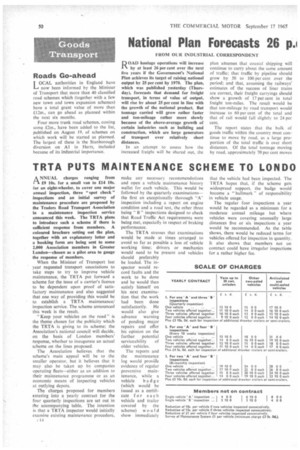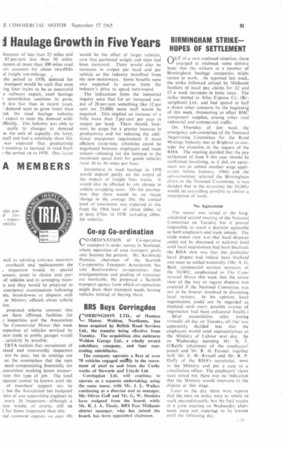National Plan Forecasts 26 p.1
Page 52

Page 53

If you've noticed an error in this article please click here to report it so we can fix it.
FROM OUR INDUSTRIAL CORRESPONDENT
ROAD haulage operations will increase by at least 26 per cent over the next five years if the Government's National Plan achieves its target of raising national output by 25 per cent by 1970. The plan, which was published yesterday (Thursday). forecasts that demand for freight transport, in terms of value of output, will rise by about 25 per cent in line with the growth of the national product. But tonnage carried will grow rather faster and ton-mileage rather more slowly because of the above-average growth of certain industries such as building and construction. which are large generators of transport over relatively short distances.
In an attempt to assess how the increased freight will he shared out, the
plan asumes that coastal shipping will continue to carry about the same amount of traffic: that traffic by pipeline should grow by 50 to 100 per cent over the period; and that, assuming the railways' estimates of the success of liner trains are correct, their freight carryings should show a growth of 17 per cent in total freight ton-miles. The result would be that ton-mileage by road transport would increase to 60 per cent of the total and that of rail would fall slightly to 24 per cent.
The report states that the hulk of goods traffic within the country must continue to move by road, as a large proportion of the total traffic is over short distances. Of the total tonnage moving by road. approximately 70 per cent moves tistances of less than 25 miles and 85 per cent less than 50 mites. .tances of more than 100 miles road ort accounts for about two-fifths al freight ton-mileage.
the period to 1970, demand for transport would be such that even ing liner trains to be as successful e railways expect, road haulage I nevertheless continue to grow, h less fast than in recent years. demand were to grow faster than ted, the road haulage industry I expect to meet the demand withifficulty. The industry was able to easily to changes in demand se the unit of capacity, the lorry, mall and had a relatively short life. was expected that productivity I continue to increase in road haul
! the period up to 1970., One factor
would be the effect of larger vehicles, now that permitted weight and sizes had been increased. There would also be increases in output per head and per vehicle as the industry benefited from the new motorways. Some benefits were also expected to accrue from the industry's drive to speed turn-round.
' The indications from the industrial inquiry were that for an increased output of 26 per cent something like 12 per cent (or 25,000) more staff would be required. This implied an increase of a little more than 2 per cent per year in output per head. There should, however. be scope for a greater increase in productivity and for reducing the additional manpower requirement if more efficient route-time schedules could be negotiated between employers and trade unions—allowing for the increase in the maximum speed limit for goods vehicles from 30 to 40 miles per hour.
Investment in road haulage in 1970 would depend partly on the extent of the impact of freight liner trains. It would also be affected by any change in vehicle scrapping rates. On the assumption that there would be no major change in the average life, the annual level of investment was expected to rise from the 1964 level of about 1:60m. to at least £70m. in 1970. including £60111. for vehicles.




















































































































































































